Business Analytics in Action: Industry Cases & Implementation
VerifiedAdded on 2023/06/09
|10
|2704
|413
Case Study
AI Summary
This case study examines the application of business analytics in the retail and automotive industries, focusing on how machine learning and AI transform customer experiences and business operations. Part A analyzes specific cases, highlighting the use of predictive and prescriptive analytics to solve business problems such as customer experience enhancement and workforce upskilling. It also addresses the challenges in implementing these analytics and provides recommendations for stakeholders. Part B describes descriptive and predictive analytics, illustrating their use with the example of Coles supermarket in Australia, emphasizing how these analytics aid in understanding market dynamics and customer preferences. Part C discusses how to integrate analytics into organizational decision-making, coordinate analytics capabilities, and source and train analytics talent, suggesting strategies for building a technology-driven culture and enhancing analytical skills within the organization. The study concludes by emphasizing the importance of data-driven decision-making for long-term growth and effective business operations.
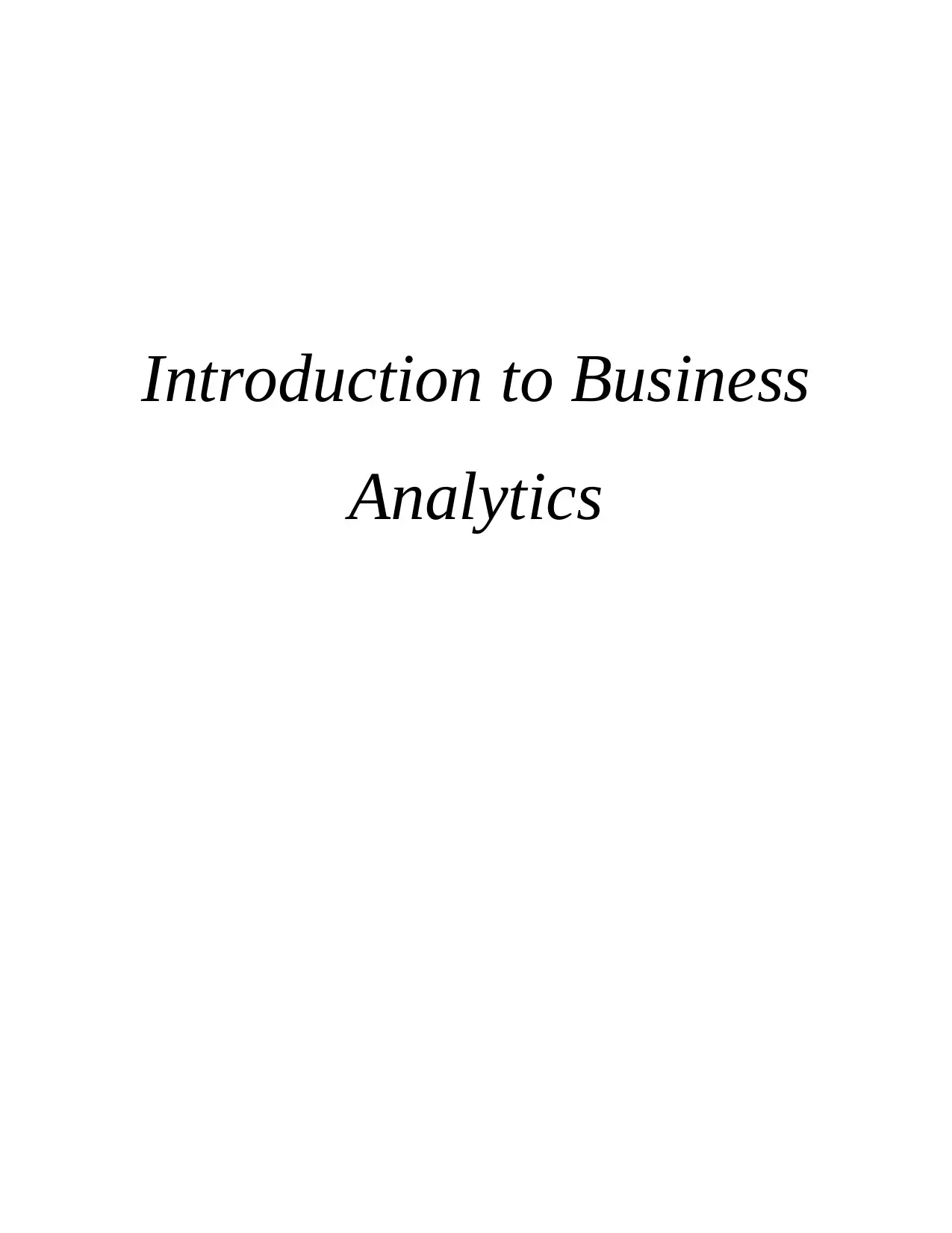
Introduction to Business
Analytics
Analytics
Paraphrase This Document
Need a fresh take? Get an instant paraphrase of this document with our AI Paraphraser

Contents
Contents...........................................................................................................................................2
INTRODUCTION...........................................................................................................................1
PART A...........................................................................................................................................1
Case study 1: How Machine Learning in Retail Is Transforming Customer Experience...........1
Case study 2: How the Use of Data and AI Is Transforming the Automotive Industry...............2
PART B...........................................................................................................................................3
Describe two different types of analytics and evaluate how each could be used as part of a
solution to a business problem.....................................................................................................3
PART C...........................................................................................................................................5
1. How do we best ingrain analytics into the organisation’s decision-making processes...........5
2. How do we organize and coordinate analytics capabilities across the organization...............5
3. How should we source, train and deploy analytics talent........................................................6
CONCLUSION................................................................................................................................6
REFERENCES................................................................................................................................7
Contents...........................................................................................................................................2
INTRODUCTION...........................................................................................................................1
PART A...........................................................................................................................................1
Case study 1: How Machine Learning in Retail Is Transforming Customer Experience...........1
Case study 2: How the Use of Data and AI Is Transforming the Automotive Industry...............2
PART B...........................................................................................................................................3
Describe two different types of analytics and evaluate how each could be used as part of a
solution to a business problem.....................................................................................................3
PART C...........................................................................................................................................5
1. How do we best ingrain analytics into the organisation’s decision-making processes...........5
2. How do we organize and coordinate analytics capabilities across the organization...............5
3. How should we source, train and deploy analytics talent........................................................6
CONCLUSION................................................................................................................................6
REFERENCES................................................................................................................................7

⊘ This is a preview!⊘
Do you want full access?
Subscribe today to unlock all pages.

Trusted by 1+ million students worldwide
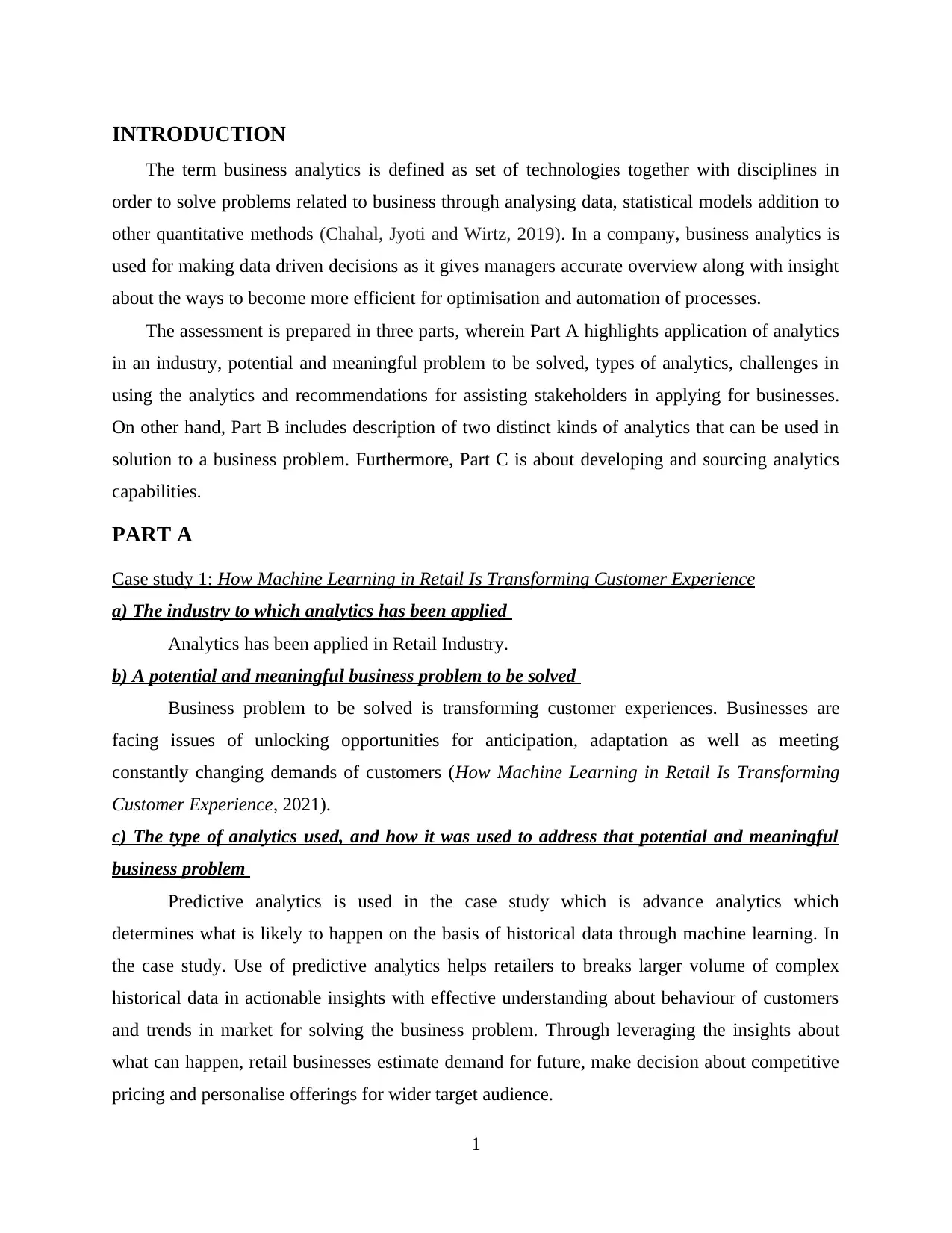
INTRODUCTION
The term business analytics is defined as set of technologies together with disciplines in
order to solve problems related to business through analysing data, statistical models addition to
other quantitative methods (Chahal, Jyoti and Wirtz, 2019). In a company, business analytics is
used for making data driven decisions as it gives managers accurate overview along with insight
about the ways to become more efficient for optimisation and automation of processes.
The assessment is prepared in three parts, wherein Part A highlights application of analytics
in an industry, potential and meaningful problem to be solved, types of analytics, challenges in
using the analytics and recommendations for assisting stakeholders in applying for businesses.
On other hand, Part B includes description of two distinct kinds of analytics that can be used in
solution to a business problem. Furthermore, Part C is about developing and sourcing analytics
capabilities.
PART A
Case study 1: How Machine Learning in Retail Is Transforming Customer Experience
a) The industry to which analytics has been applied
Analytics has been applied in Retail Industry.
b) A potential and meaningful business problem to be solved
Business problem to be solved is transforming customer experiences. Businesses are
facing issues of unlocking opportunities for anticipation, adaptation as well as meeting
constantly changing demands of customers (How Machine Learning in Retail Is Transforming
Customer Experience, 2021).
c) The type of analytics used, and how it was used to address that potential and meaningful
business problem
Predictive analytics is used in the case study which is advance analytics which
determines what is likely to happen on the basis of historical data through machine learning. In
the case study. Use of predictive analytics helps retailers to breaks larger volume of complex
historical data in actionable insights with effective understanding about behaviour of customers
and trends in market for solving the business problem. Through leveraging the insights about
what can happen, retail businesses estimate demand for future, make decision about competitive
pricing and personalise offerings for wider target audience.
1
The term business analytics is defined as set of technologies together with disciplines in
order to solve problems related to business through analysing data, statistical models addition to
other quantitative methods (Chahal, Jyoti and Wirtz, 2019). In a company, business analytics is
used for making data driven decisions as it gives managers accurate overview along with insight
about the ways to become more efficient for optimisation and automation of processes.
The assessment is prepared in three parts, wherein Part A highlights application of analytics
in an industry, potential and meaningful problem to be solved, types of analytics, challenges in
using the analytics and recommendations for assisting stakeholders in applying for businesses.
On other hand, Part B includes description of two distinct kinds of analytics that can be used in
solution to a business problem. Furthermore, Part C is about developing and sourcing analytics
capabilities.
PART A
Case study 1: How Machine Learning in Retail Is Transforming Customer Experience
a) The industry to which analytics has been applied
Analytics has been applied in Retail Industry.
b) A potential and meaningful business problem to be solved
Business problem to be solved is transforming customer experiences. Businesses are
facing issues of unlocking opportunities for anticipation, adaptation as well as meeting
constantly changing demands of customers (How Machine Learning in Retail Is Transforming
Customer Experience, 2021).
c) The type of analytics used, and how it was used to address that potential and meaningful
business problem
Predictive analytics is used in the case study which is advance analytics which
determines what is likely to happen on the basis of historical data through machine learning. In
the case study. Use of predictive analytics helps retailers to breaks larger volume of complex
historical data in actionable insights with effective understanding about behaviour of customers
and trends in market for solving the business problem. Through leveraging the insights about
what can happen, retail businesses estimate demand for future, make decision about competitive
pricing and personalise offerings for wider target audience.
1
Paraphrase This Document
Need a fresh take? Get an instant paraphrase of this document with our AI Paraphraser
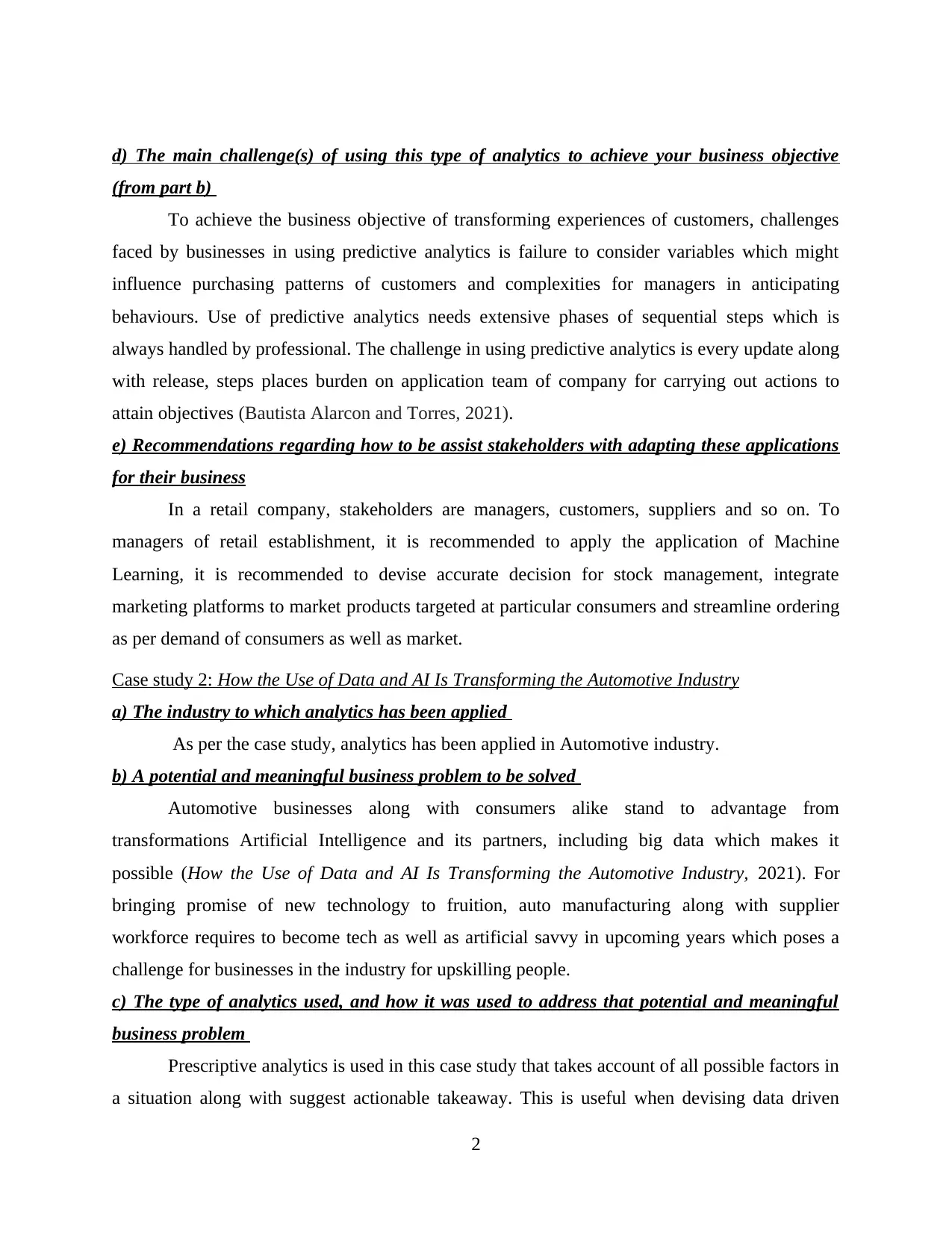
d) The main challenge(s) of using this type of analytics to achieve your business objective
(from part b)
To achieve the business objective of transforming experiences of customers, challenges
faced by businesses in using predictive analytics is failure to consider variables which might
influence purchasing patterns of customers and complexities for managers in anticipating
behaviours. Use of predictive analytics needs extensive phases of sequential steps which is
always handled by professional. The challenge in using predictive analytics is every update along
with release, steps places burden on application team of company for carrying out actions to
attain objectives (Bautista Alarcon and Torres, 2021).
e) Recommendations regarding how to be assist stakeholders with adapting these applications
for their business
In a retail company, stakeholders are managers, customers, suppliers and so on. To
managers of retail establishment, it is recommended to apply the application of Machine
Learning, it is recommended to devise accurate decision for stock management, integrate
marketing platforms to market products targeted at particular consumers and streamline ordering
as per demand of consumers as well as market.
Case study 2: How the Use of Data and AI Is Transforming the Automotive Industry
a) The industry to which analytics has been applied
As per the case study, analytics has been applied in Automotive industry.
b) A potential and meaningful business problem to be solved
Automotive businesses along with consumers alike stand to advantage from
transformations Artificial Intelligence and its partners, including big data which makes it
possible (How the Use of Data and AI Is Transforming the Automotive Industry, 2021). For
bringing promise of new technology to fruition, auto manufacturing along with supplier
workforce requires to become tech as well as artificial savvy in upcoming years which poses a
challenge for businesses in the industry for upskilling people.
c) The type of analytics used, and how it was used to address that potential and meaningful
business problem
Prescriptive analytics is used in this case study that takes account of all possible factors in
a situation along with suggest actionable takeaway. This is useful when devising data driven
2
(from part b)
To achieve the business objective of transforming experiences of customers, challenges
faced by businesses in using predictive analytics is failure to consider variables which might
influence purchasing patterns of customers and complexities for managers in anticipating
behaviours. Use of predictive analytics needs extensive phases of sequential steps which is
always handled by professional. The challenge in using predictive analytics is every update along
with release, steps places burden on application team of company for carrying out actions to
attain objectives (Bautista Alarcon and Torres, 2021).
e) Recommendations regarding how to be assist stakeholders with adapting these applications
for their business
In a retail company, stakeholders are managers, customers, suppliers and so on. To
managers of retail establishment, it is recommended to apply the application of Machine
Learning, it is recommended to devise accurate decision for stock management, integrate
marketing platforms to market products targeted at particular consumers and streamline ordering
as per demand of consumers as well as market.
Case study 2: How the Use of Data and AI Is Transforming the Automotive Industry
a) The industry to which analytics has been applied
As per the case study, analytics has been applied in Automotive industry.
b) A potential and meaningful business problem to be solved
Automotive businesses along with consumers alike stand to advantage from
transformations Artificial Intelligence and its partners, including big data which makes it
possible (How the Use of Data and AI Is Transforming the Automotive Industry, 2021). For
bringing promise of new technology to fruition, auto manufacturing along with supplier
workforce requires to become tech as well as artificial savvy in upcoming years which poses a
challenge for businesses in the industry for upskilling people.
c) The type of analytics used, and how it was used to address that potential and meaningful
business problem
Prescriptive analytics is used in this case study that takes account of all possible factors in
a situation along with suggest actionable takeaway. This is useful when devising data driven
2
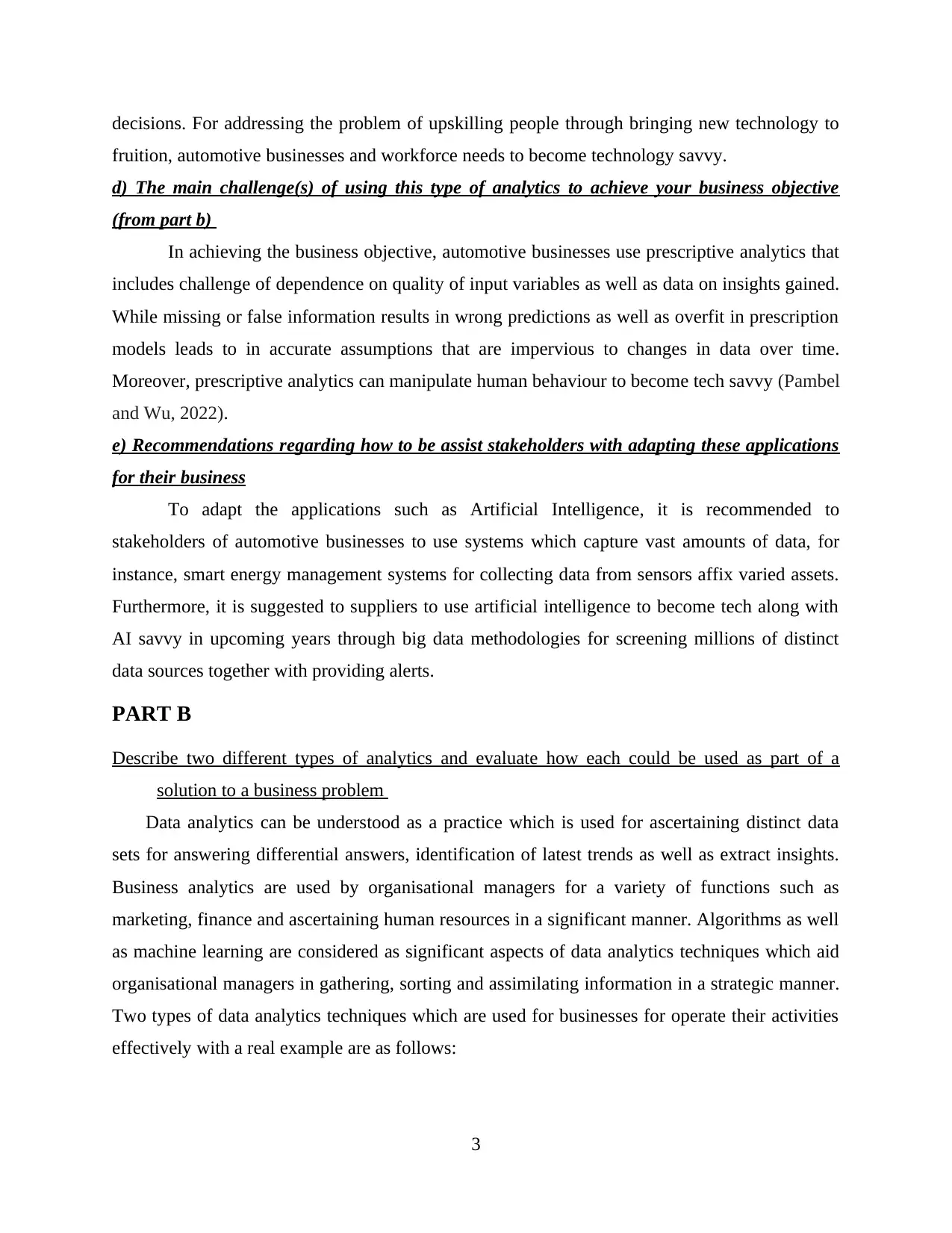
decisions. For addressing the problem of upskilling people through bringing new technology to
fruition, automotive businesses and workforce needs to become technology savvy.
d) The main challenge(s) of using this type of analytics to achieve your business objective
(from part b)
In achieving the business objective, automotive businesses use prescriptive analytics that
includes challenge of dependence on quality of input variables as well as data on insights gained.
While missing or false information results in wrong predictions as well as overfit in prescription
models leads to in accurate assumptions that are impervious to changes in data over time.
Moreover, prescriptive analytics can manipulate human behaviour to become tech savvy (Pambel
and Wu, 2022).
e) Recommendations regarding how to be assist stakeholders with adapting these applications
for their business
To adapt the applications such as Artificial Intelligence, it is recommended to
stakeholders of automotive businesses to use systems which capture vast amounts of data, for
instance, smart energy management systems for collecting data from sensors affix varied assets.
Furthermore, it is suggested to suppliers to use artificial intelligence to become tech along with
AI savvy in upcoming years through big data methodologies for screening millions of distinct
data sources together with providing alerts.
PART B
Describe two different types of analytics and evaluate how each could be used as part of a
solution to a business problem
Data analytics can be understood as a practice which is used for ascertaining distinct data
sets for answering differential answers, identification of latest trends as well as extract insights.
Business analytics are used by organisational managers for a variety of functions such as
marketing, finance and ascertaining human resources in a significant manner. Algorithms as well
as machine learning are considered as significant aspects of data analytics techniques which aid
organisational managers in gathering, sorting and assimilating information in a strategic manner.
Two types of data analytics techniques which are used for businesses for operate their activities
effectively with a real example are as follows:
3
fruition, automotive businesses and workforce needs to become technology savvy.
d) The main challenge(s) of using this type of analytics to achieve your business objective
(from part b)
In achieving the business objective, automotive businesses use prescriptive analytics that
includes challenge of dependence on quality of input variables as well as data on insights gained.
While missing or false information results in wrong predictions as well as overfit in prescription
models leads to in accurate assumptions that are impervious to changes in data over time.
Moreover, prescriptive analytics can manipulate human behaviour to become tech savvy (Pambel
and Wu, 2022).
e) Recommendations regarding how to be assist stakeholders with adapting these applications
for their business
To adapt the applications such as Artificial Intelligence, it is recommended to
stakeholders of automotive businesses to use systems which capture vast amounts of data, for
instance, smart energy management systems for collecting data from sensors affix varied assets.
Furthermore, it is suggested to suppliers to use artificial intelligence to become tech along with
AI savvy in upcoming years through big data methodologies for screening millions of distinct
data sources together with providing alerts.
PART B
Describe two different types of analytics and evaluate how each could be used as part of a
solution to a business problem
Data analytics can be understood as a practice which is used for ascertaining distinct data
sets for answering differential answers, identification of latest trends as well as extract insights.
Business analytics are used by organisational managers for a variety of functions such as
marketing, finance and ascertaining human resources in a significant manner. Algorithms as well
as machine learning are considered as significant aspects of data analytics techniques which aid
organisational managers in gathering, sorting and assimilating information in a strategic manner.
Two types of data analytics techniques which are used for businesses for operate their activities
effectively with a real example are as follows:
3
⊘ This is a preview!⊘
Do you want full access?
Subscribe today to unlock all pages.

Trusted by 1+ million students worldwide
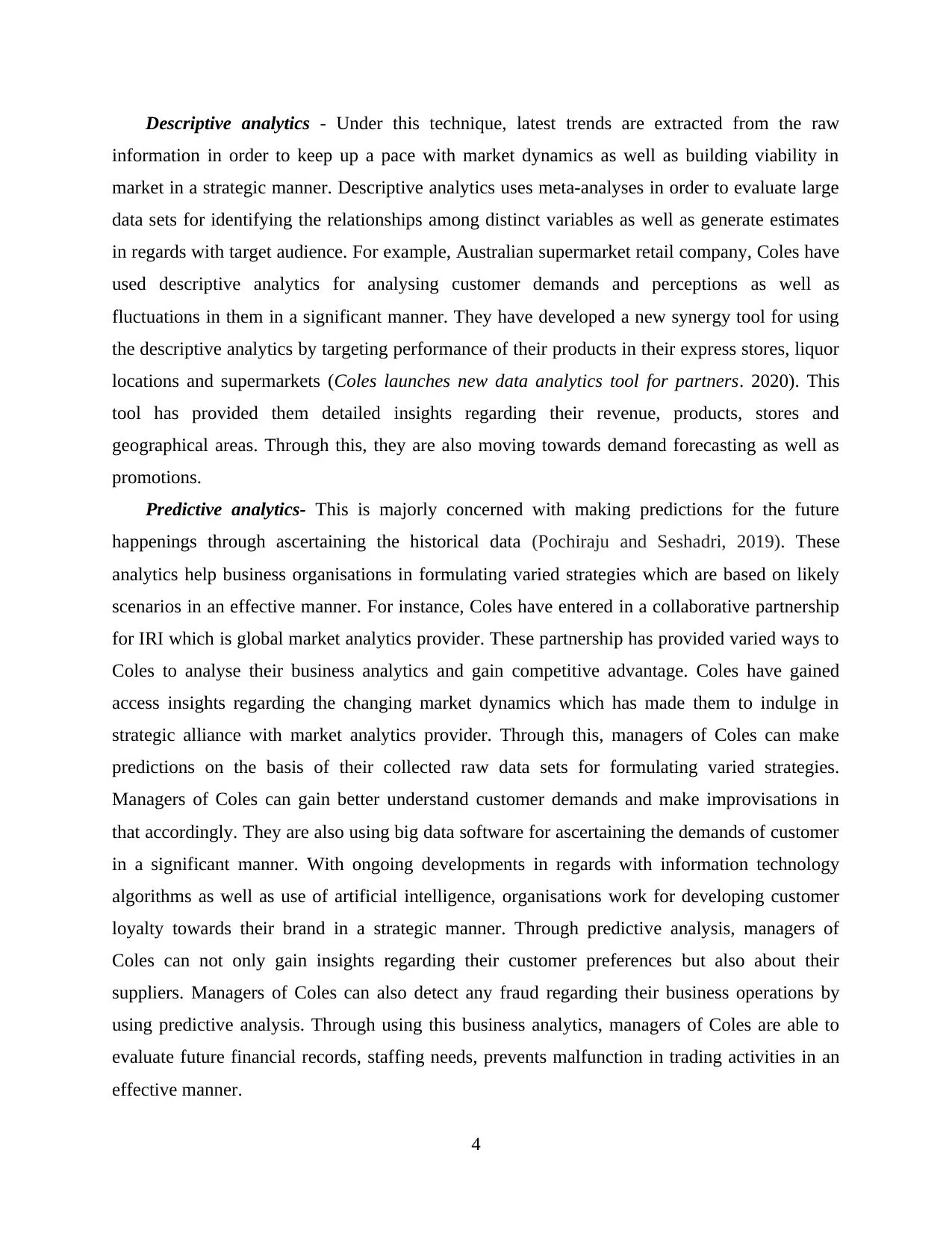
Descriptive analytics - Under this technique, latest trends are extracted from the raw
information in order to keep up a pace with market dynamics as well as building viability in
market in a strategic manner. Descriptive analytics uses meta-analyses in order to evaluate large
data sets for identifying the relationships among distinct variables as well as generate estimates
in regards with target audience. For example, Australian supermarket retail company, Coles have
used descriptive analytics for analysing customer demands and perceptions as well as
fluctuations in them in a significant manner. They have developed a new synergy tool for using
the descriptive analytics by targeting performance of their products in their express stores, liquor
locations and supermarkets (Coles launches new data analytics tool for partners. 2020). This
tool has provided them detailed insights regarding their revenue, products, stores and
geographical areas. Through this, they are also moving towards demand forecasting as well as
promotions.
Predictive analytics- This is majorly concerned with making predictions for the future
happenings through ascertaining the historical data (Pochiraju and Seshadri, 2019). These
analytics help business organisations in formulating varied strategies which are based on likely
scenarios in an effective manner. For instance, Coles have entered in a collaborative partnership
for IRI which is global market analytics provider. These partnership has provided varied ways to
Coles to analyse their business analytics and gain competitive advantage. Coles have gained
access insights regarding the changing market dynamics which has made them to indulge in
strategic alliance with market analytics provider. Through this, managers of Coles can make
predictions on the basis of their collected raw data sets for formulating varied strategies.
Managers of Coles can gain better understand customer demands and make improvisations in
that accordingly. They are also using big data software for ascertaining the demands of customer
in a significant manner. With ongoing developments in regards with information technology
algorithms as well as use of artificial intelligence, organisations work for developing customer
loyalty towards their brand in a strategic manner. Through predictive analysis, managers of
Coles can not only gain insights regarding their customer preferences but also about their
suppliers. Managers of Coles can also detect any fraud regarding their business operations by
using predictive analysis. Through using this business analytics, managers of Coles are able to
evaluate future financial records, staffing needs, prevents malfunction in trading activities in an
effective manner.
4
information in order to keep up a pace with market dynamics as well as building viability in
market in a strategic manner. Descriptive analytics uses meta-analyses in order to evaluate large
data sets for identifying the relationships among distinct variables as well as generate estimates
in regards with target audience. For example, Australian supermarket retail company, Coles have
used descriptive analytics for analysing customer demands and perceptions as well as
fluctuations in them in a significant manner. They have developed a new synergy tool for using
the descriptive analytics by targeting performance of their products in their express stores, liquor
locations and supermarkets (Coles launches new data analytics tool for partners. 2020). This
tool has provided them detailed insights regarding their revenue, products, stores and
geographical areas. Through this, they are also moving towards demand forecasting as well as
promotions.
Predictive analytics- This is majorly concerned with making predictions for the future
happenings through ascertaining the historical data (Pochiraju and Seshadri, 2019). These
analytics help business organisations in formulating varied strategies which are based on likely
scenarios in an effective manner. For instance, Coles have entered in a collaborative partnership
for IRI which is global market analytics provider. These partnership has provided varied ways to
Coles to analyse their business analytics and gain competitive advantage. Coles have gained
access insights regarding the changing market dynamics which has made them to indulge in
strategic alliance with market analytics provider. Through this, managers of Coles can make
predictions on the basis of their collected raw data sets for formulating varied strategies.
Managers of Coles can gain better understand customer demands and make improvisations in
that accordingly. They are also using big data software for ascertaining the demands of customer
in a significant manner. With ongoing developments in regards with information technology
algorithms as well as use of artificial intelligence, organisations work for developing customer
loyalty towards their brand in a strategic manner. Through predictive analysis, managers of
Coles can not only gain insights regarding their customer preferences but also about their
suppliers. Managers of Coles can also detect any fraud regarding their business operations by
using predictive analysis. Through using this business analytics, managers of Coles are able to
evaluate future financial records, staffing needs, prevents malfunction in trading activities in an
effective manner.
4
Paraphrase This Document
Need a fresh take? Get an instant paraphrase of this document with our AI Paraphraser
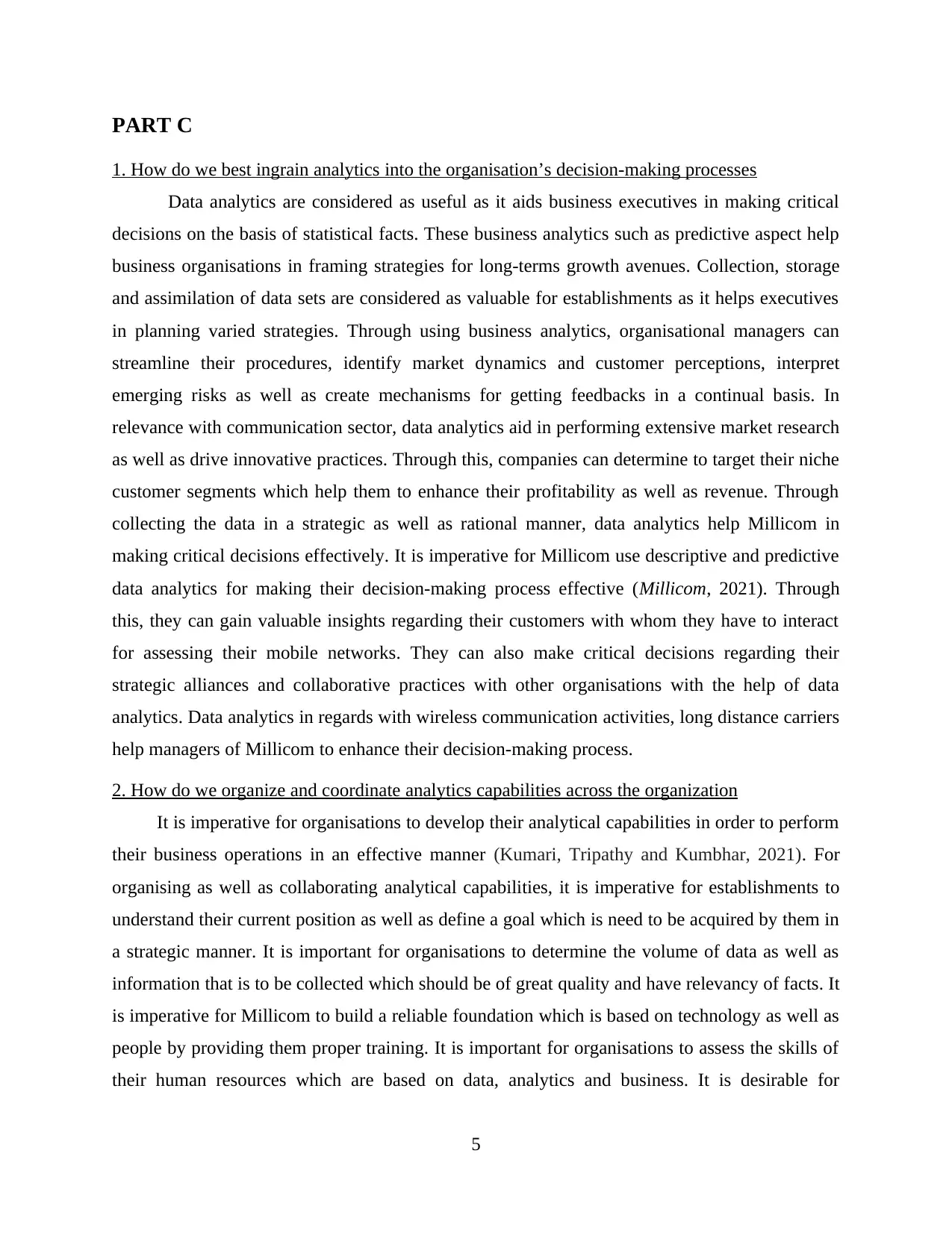
PART C
1. How do we best ingrain analytics into the organisation’s decision-making processes
Data analytics are considered as useful as it aids business executives in making critical
decisions on the basis of statistical facts. These business analytics such as predictive aspect help
business organisations in framing strategies for long-terms growth avenues. Collection, storage
and assimilation of data sets are considered as valuable for establishments as it helps executives
in planning varied strategies. Through using business analytics, organisational managers can
streamline their procedures, identify market dynamics and customer perceptions, interpret
emerging risks as well as create mechanisms for getting feedbacks in a continual basis. In
relevance with communication sector, data analytics aid in performing extensive market research
as well as drive innovative practices. Through this, companies can determine to target their niche
customer segments which help them to enhance their profitability as well as revenue. Through
collecting the data in a strategic as well as rational manner, data analytics help Millicom in
making critical decisions effectively. It is imperative for Millicom use descriptive and predictive
data analytics for making their decision-making process effective (Millicom, 2021). Through
this, they can gain valuable insights regarding their customers with whom they have to interact
for assessing their mobile networks. They can also make critical decisions regarding their
strategic alliances and collaborative practices with other organisations with the help of data
analytics. Data analytics in regards with wireless communication activities, long distance carriers
help managers of Millicom to enhance their decision-making process.
2. How do we organize and coordinate analytics capabilities across the organization
It is imperative for organisations to develop their analytical capabilities in order to perform
their business operations in an effective manner (Kumari, Tripathy and Kumbhar, 2021). For
organising as well as collaborating analytical capabilities, it is imperative for establishments to
understand their current position as well as define a goal which is need to be acquired by them in
a strategic manner. It is important for organisations to determine the volume of data as well as
information that is to be collected which should be of great quality and have relevancy of facts. It
is imperative for Millicom to build a reliable foundation which is based on technology as well as
people by providing them proper training. It is important for organisations to assess the skills of
their human resources which are based on data, analytics and business. It is desirable for
5
1. How do we best ingrain analytics into the organisation’s decision-making processes
Data analytics are considered as useful as it aids business executives in making critical
decisions on the basis of statistical facts. These business analytics such as predictive aspect help
business organisations in framing strategies for long-terms growth avenues. Collection, storage
and assimilation of data sets are considered as valuable for establishments as it helps executives
in planning varied strategies. Through using business analytics, organisational managers can
streamline their procedures, identify market dynamics and customer perceptions, interpret
emerging risks as well as create mechanisms for getting feedbacks in a continual basis. In
relevance with communication sector, data analytics aid in performing extensive market research
as well as drive innovative practices. Through this, companies can determine to target their niche
customer segments which help them to enhance their profitability as well as revenue. Through
collecting the data in a strategic as well as rational manner, data analytics help Millicom in
making critical decisions effectively. It is imperative for Millicom use descriptive and predictive
data analytics for making their decision-making process effective (Millicom, 2021). Through
this, they can gain valuable insights regarding their customers with whom they have to interact
for assessing their mobile networks. They can also make critical decisions regarding their
strategic alliances and collaborative practices with other organisations with the help of data
analytics. Data analytics in regards with wireless communication activities, long distance carriers
help managers of Millicom to enhance their decision-making process.
2. How do we organize and coordinate analytics capabilities across the organization
It is imperative for organisations to develop their analytical capabilities in order to perform
their business operations in an effective manner (Kumari, Tripathy and Kumbhar, 2021). For
organising as well as collaborating analytical capabilities, it is imperative for establishments to
understand their current position as well as define a goal which is need to be acquired by them in
a strategic manner. It is important for organisations to determine the volume of data as well as
information that is to be collected which should be of great quality and have relevancy of facts. It
is imperative for Millicom to build a reliable foundation which is based on technology as well as
people by providing them proper training. It is important for organisations to assess the skills of
their human resources which are based on data, analytics and business. It is desirable for
5

Millicom to develop a technological driven organisational structure as well as culture in order to
enhance their capabilities and decision-making process. It is important for Millicom to encourage
their teams in order to take an active role in regards with measurement as well as analysis of data
in a strategic manner. Through adopting above described systematic procedure, Millicom can
enhance their capabilities for using data analytics in an effective manner.
3. How should we source, train and deploy analytics talent
In order to source, train and deploy analytics team in an effective manner, Millicom can
analyse the need of such hires by critically evaluating their job description. They can source
business analytics team through online portals which will help them to hire the best possible
talents (Kimbrough and Lau, 2018). For providing training to them, it is imperative for Millicom
to analyse their talent specification in order to enhance them in a strategic manner. For
developing their talents, new hires should be given a challenging environment as well as proper
autonomy to them for making critical decisions in a better manner. It is imperative for them to
analyse their job description as well as qualifications of their data analytics team in order to
perform in a strategic manner.
CONCLUSION
As per mentioned information, it is concluded that business analytics streamline operations,
enhance security, personalise customer experience, inform business decision making and
mitigate risks. Retail and Automotive Industry uses data analytics for solving issues of meeting
customer demands and upskilling people with tech and artificial savvy. Types of analytics that
are predictive and descriptive for solving business problems.
6
enhance their capabilities and decision-making process. It is important for Millicom to encourage
their teams in order to take an active role in regards with measurement as well as analysis of data
in a strategic manner. Through adopting above described systematic procedure, Millicom can
enhance their capabilities for using data analytics in an effective manner.
3. How should we source, train and deploy analytics talent
In order to source, train and deploy analytics team in an effective manner, Millicom can
analyse the need of such hires by critically evaluating their job description. They can source
business analytics team through online portals which will help them to hire the best possible
talents (Kimbrough and Lau, 2018). For providing training to them, it is imperative for Millicom
to analyse their talent specification in order to enhance them in a strategic manner. For
developing their talents, new hires should be given a challenging environment as well as proper
autonomy to them for making critical decisions in a better manner. It is imperative for them to
analyse their job description as well as qualifications of their data analytics team in order to
perform in a strategic manner.
CONCLUSION
As per mentioned information, it is concluded that business analytics streamline operations,
enhance security, personalise customer experience, inform business decision making and
mitigate risks. Retail and Automotive Industry uses data analytics for solving issues of meeting
customer demands and upskilling people with tech and artificial savvy. Types of analytics that
are predictive and descriptive for solving business problems.
6
⊘ This is a preview!⊘
Do you want full access?
Subscribe today to unlock all pages.

Trusted by 1+ million students worldwide

REFERENCES
Books and Journals:
Bautista Alarcon, X. and Torres, C., 2021, March. Implementing Business Analytics Software to
Optimize Coiled Tubing Operations: A Digital Approach to Operations Efficiency.
In SPE/ICoTA Well Intervention Conference and Exhibition. OnePetro.
Chahal, H., Jyoti, J. and Wirtz, J., 2019. Business analytics: Concept and applications.
In Understanding the role of Business Analytics (pp. 1-8).
Kimbrough, S. O. and Lau, H. C., 2018. Business analytics for decision making. Chapman and
Hall/CRC.
Kumari, S., Tripathy, K .K. and Kumbhar, V. eds., 2021. Application of Big Data and Business
Analytics. Emerald Publishing Limited.
Pambel, F. and Wu, Z., 2022. The Elements of Intelligent Business Analytics. Handbook of
Research on Foundations and Applications of Intelligent Business Analytics, p.1.
Pochiraju, B. and Seshadri, S. eds., 2019. Essentials of Business Analytics: An Introduction to
the Methodology and its Applications (Vol. 264). Springer.
Online:
Cameron N., 2020. Coles launches new data analytics tool for partners. [Online]. Available
through: <https://www.cmo.com.au/article/679940/coles-launches-new-data-analytics-
tool-partners/
How Machine Learning in Retail Is Transforming Customer Experience. 2021. [Online].
Available through: https://www.rishabhsoft.com/blog/machine-learning-in-retail.
How the Use of Data and AI Is Transforming the Automotive Industry. 2021. [Online]. Available
through: <https://emeritus.org/blog/big-data-ai-in-the-automotive-industry/>
Millicom. 2021. [Online]. Available through: <https://www.millicom.com/>
7
Books and Journals:
Bautista Alarcon, X. and Torres, C., 2021, March. Implementing Business Analytics Software to
Optimize Coiled Tubing Operations: A Digital Approach to Operations Efficiency.
In SPE/ICoTA Well Intervention Conference and Exhibition. OnePetro.
Chahal, H., Jyoti, J. and Wirtz, J., 2019. Business analytics: Concept and applications.
In Understanding the role of Business Analytics (pp. 1-8).
Kimbrough, S. O. and Lau, H. C., 2018. Business analytics for decision making. Chapman and
Hall/CRC.
Kumari, S., Tripathy, K .K. and Kumbhar, V. eds., 2021. Application of Big Data and Business
Analytics. Emerald Publishing Limited.
Pambel, F. and Wu, Z., 2022. The Elements of Intelligent Business Analytics. Handbook of
Research on Foundations and Applications of Intelligent Business Analytics, p.1.
Pochiraju, B. and Seshadri, S. eds., 2019. Essentials of Business Analytics: An Introduction to
the Methodology and its Applications (Vol. 264). Springer.
Online:
Cameron N., 2020. Coles launches new data analytics tool for partners. [Online]. Available
through: <https://www.cmo.com.au/article/679940/coles-launches-new-data-analytics-
tool-partners/
How Machine Learning in Retail Is Transforming Customer Experience. 2021. [Online].
Available through: https://www.rishabhsoft.com/blog/machine-learning-in-retail.
How the Use of Data and AI Is Transforming the Automotive Industry. 2021. [Online]. Available
through: <https://emeritus.org/blog/big-data-ai-in-the-automotive-industry/>
Millicom. 2021. [Online]. Available through: <https://www.millicom.com/>
7
1 out of 10
Related Documents
Your All-in-One AI-Powered Toolkit for Academic Success.
+13062052269
info@desklib.com
Available 24*7 on WhatsApp / Email
![[object Object]](/_next/static/media/star-bottom.7253800d.svg)
Unlock your academic potential
Copyright © 2020–2025 A2Z Services. All Rights Reserved. Developed and managed by ZUCOL.





